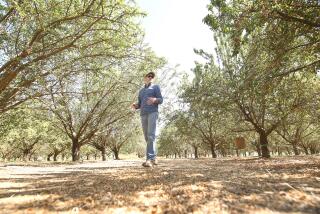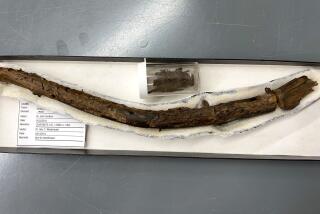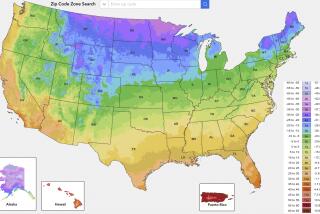Researchers Getting Warmer in Quest for Cold-Resistant Plants
Last month when a blast of frigid air descended on Central Valley orange and lemon trees, growers hauled out a low-tech arsenal of smudge pots, wind machines and water sprayers in a feeble effort to limit damage.
As California fruit and vegetable farmers continue to tote up their losses--the latest estimate is $656 million--the situation is a chilling reminder of the long and largely fruitless struggle to develop cold-tolerant crops.
Traditional breeding has met with limited success at best. Biotechnology holds promise, but past efforts involving the splicing of genes from other species have frightened the public.
Even growers have mixed emotions about the prospect of achieving cold hardiness in trees, fearing that a frost-proof variety could aid rivals in Florida or open the door to unwelcome competition from northern regions that are too inhospitable for citrus.
After decades of research, however, some scientists are making progress on the cold front. One development in particular could hold profound implications for agriculture.
Last year, a plant molecular biologist at Michigan State University created a cold-hardy strain of the lowly mustard plant Arabidopsis, the lab rat of plant science. His team did this by genetically engineering the plant to overproduce a protein that activates other genes that help the plant withstand the ill effects of freezing weather.
By tricking plants into thinking they are cold even in balmy temperatures, theorizes lead researcher Michael Thomashow, they could be induced to protect themselves from cold snaps throughout the growing season.
Still, commercial applications are years off.
âItâs exciting, but itâs a ways away from being a product,â said Michael Fromm, president and chief executive of Mendel Biotechnology Inc. of Hayward, Calif., which has licensed Thomashowâs technology and is beginning to develop cold-tolerant vegetable, corn, soy and canola plants.
The stakes are high, noted Al Peterlin, chief meteorologist at the U.S. Department of Agriculture.
âThere are two really significant threats to agriculture--drought and freezing--which can do more damage over a short period than any of the water events,â Peterlin said.
âEl Nino was on everybodyâs lips every day for 13 to 14 months,â he said, recalling the wet, cool weather patterns that wreaked havoc with crop maturation and plantings last year in California. Yet the total damage tied to El Nino was $532 million, well below the figure linked so far to last monthâs cold snap.
Through traditional breeding methods over four decades, citrus growers have developed rootstocks that are more tolerant of frost. But the industry has yet to generate anything that can stand up to sudden, punishing freezes.
That is why Thomashowâs work intrigues plant scientists.
Usually, protective genes âturn onâ gradually as a plant is exposed to slowly declining temperatures. But in the new strain, developed with a relatively simple manipulation of one of the plantâs own genes that then serves as a âmaster switch,â they are active all the time. That enables the Arabidopsis to survive sudden drops to below its normal killing temperature.
One hope, Thomashow said, is that if the genes are switched on throughout the season, they could help crops withstand the chills early or late in the growing season, which can cause the biggest damage. Fathey Sarhan, a researcher at the University of Quebec in Montreal, reported last year that his work with wheat backs up the notion that cold-regulated genes could be controlled by a master switch.
In Florida, where the USDA has spent decades on the trail of frost-proof citrus, researchers have found that species with high levels of cold resistance bear bad-tasting fruit, said Jose Chaparro, a research geneticist with the Horticultural Research Lab in Orlando.
Chaparro figures the lab is five to seven years away from developing a cold-hardy but palatable fruit for backyard gardeners. But a commercial variety, he adds, will require 16 to 20 more years.
Back in the 1980s, California scientists investigated another frost-fighting approach involving genetic modification.
Steve Lindow, a UC Berkeley plant pathologist and microbial ecologist, found a common, harmless bacterium that lived on plants and contained a protein that promoted frost damage. Using recombinant DNA techniques, he disabled the bacteriumâs âice- nucleationâ protein. Growers, he figured, could spray the variant, which he called âice minus,â onto plants, displacing the ice-promoting bacteria.
In 1987, after four years of protests, lawsuits and delays, a moon-suited scientist sprayed the altered bacteria on a strawberry patch in the eastern Bay Area community of Brentwood. It was the first authorized release of a genetically engineered organism into the environment.
Although the test was successful, federal regulators had classified ice minus as a pesticide. Scientists and industry abandoned the technology as too expensive and troublesome, given the backlash.
Since then, Lindow has developed a naturally occurring bacterial strain that acts in the same way. He said it is most commonly used for frost control in pears and apples.
Because damaging freezes occur infrequently in California, researchers are more inclined to spend time and dollars developing crop varieties that resist pests and diseases or that improve on traits--say, seedless citrus.
Meanwhile, many growers question the benefits of cold hardiness.
âItâs so easy to overproduce just about anything these days that breeding them so they can be produced in other inhospitable parts is not a high priority,â said Rachel Elkins, a University of California cooperative extension farm advisor who works with apple and pear growers in Lake and Mendocino counties. âItâs hard enough to make a living.â
*
CITRUS SQUEEZE
Decemberâs freeze has left about 13,000 Central Valley farm workers without jobs. A3







